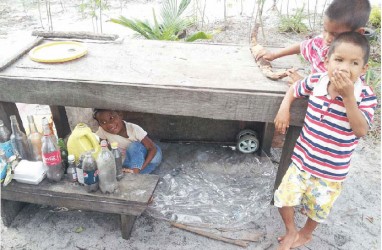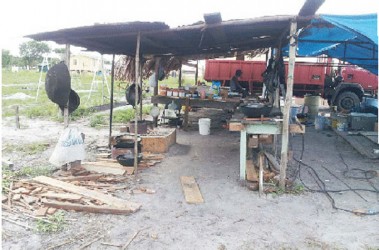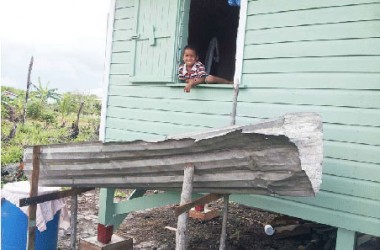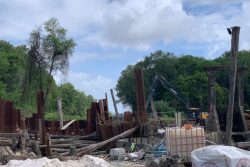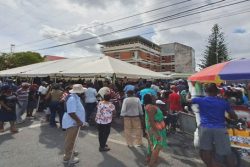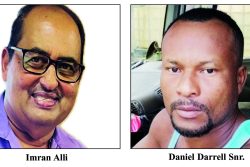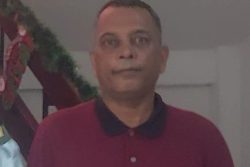Story and photos by Mandy Thompson
Most people have probably never heard of Swan other than those who actually live in that general area; it is not even in Guyana’s Gazetteer. For first-time visitors it’s a world quite different from what they know.
This secluded community is located between Kuru-Kururu and Marudi on the Linden Highway and is made up of people who share a simple way of life. Getting to Swan requires traversing a white sand trail which is surrounded by thick vegetation. Hope of finding the village runs low as the journey drags on and there is an absence of signs of human life.
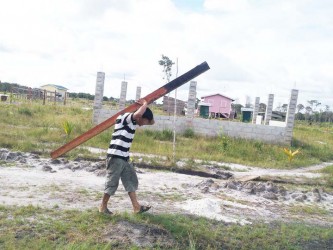
But as the trail gets closer to the village, it is possible to catch sight of a few persons disappearing through a short-cut in the bushes.
Nevertheless eventually this newspaper found the predominantly Amerindian community which comprises about 100 homes. The atmosphere in Swan is quite peaceful and refreshing. There is a fresh cool breeze, children play, a few residents sit on their steps enjoying a chat and a few jokes to while away their time on a Saturday afternoon.
According to villagers Swan is one of those communities which was created when government relocated a number of persons living along the highway. Houses in the village were built by the Food for the Poor organization and given to them free of cost. About 20 more of the two-bedroom homes are being constructed by the organization, they said.
The houses in Swan were painted in about three different colours, but the outdoor washrooms were all painted green. There was no fence around any of the homes and doors could be seen standing wide open with the occupants absent. This is because there were no serious crimes in the village, except for a few missing buckets, residents said.
Every yard in Swan has some amount of farming going on. Cassava and pineapple plants were seen in almost all the yards, and some residents even had their flower gardens between their crops. But no one in the village does farming for a living, villagers noted. They said that most residents go out of the community and work as drivers or labourers to earn their wages.
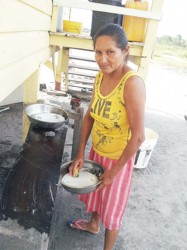
Housewife Shabana recently moved to Swan where she resides with her husband and three children. She was making a purchase from a door-to-door clothes vendor through her bedroom window when Sunday Stabroek approached her. For Shabana, life in Swan is quiet but entertaining, because she would normally spend her leisure time enjoying a game of cricket. People in the village said that cricket is a popular sport among residents ‒ both men and women. They said that teams from the East Coast and Friendship also visited the area every other Sunday to compete against the locals.
Shabana’s children attend school at Kuru-Kururu, a community some distance away, like other children in Swan. She said that all of the kids go to school but there can be a hassle for those who do not have the $1000 bus fare for their child per week.
A bus would come in the morning to take the children to school. The children of parents who cannot afford it walk to and from school every day – an hour each way. Owing to the fact that buses or cars do not operate in the village, residents said they used taxis to get in and out at a cost of $1000. Those who cannot afford this fare would have to walk to the main road on the highway, Shabana said.
According to her, secondary health care is accessible at the Kuru-Kururu Health Centre and for more complicated issues persons would go the Diamond Diagnostic Centre or the Georgetown Hospital. There are three small shops in the village that meet the basic needs of residents, but most of their grocery requirements are supplied by the grocery vans that visit the area at weekends.
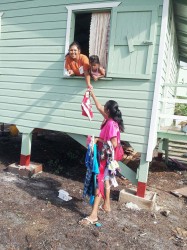
Everyone in the village belongs to the Christian faith and either attends the Seventh Day Adventist or the Full Gospel churches in the community.
Swan was described as a happy place where people do not fight with each other, and this is what Shabana said she likes about her village.
It also has no electricity but there are solar panels donated by the government, that can power a light bulb in most homes. However, residents said the problem with the solar panels is that they often lose power during the course of the night and especially when there is insufficient sunlight during the day. For those who do not have solar panels, lamps and generators are used.

There is also the absence of direct access to potable water. A solar powered well comprising four black water tanks supplies water to the few standpipes located at various points in the community, residents said. They added that some of the pipes are not working and as such they had to depend on rainwater or the creek for their daily needs.
Resident Ralph Charles said he, his three children and his in-laws shared the two bedroom home they live in. Charles does not have a fixed job and would undertake labouring jobs outside the community to sustain his family. He said that the two bedroom house makes a comfortable home for the seven of them who share it, since they are not in conflict with each other. Charles was very reticent about speaking to the Sunday Stabroek but he still allowed us to take a picture of himself and his family.
Life in Swan is described as nice for most residents, but they all said the problem affecting them most is flooding. Apart from this, they said, life proceeds peacefully in Swan.
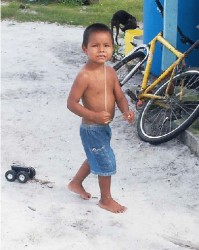
taken with the string in his mouth.
